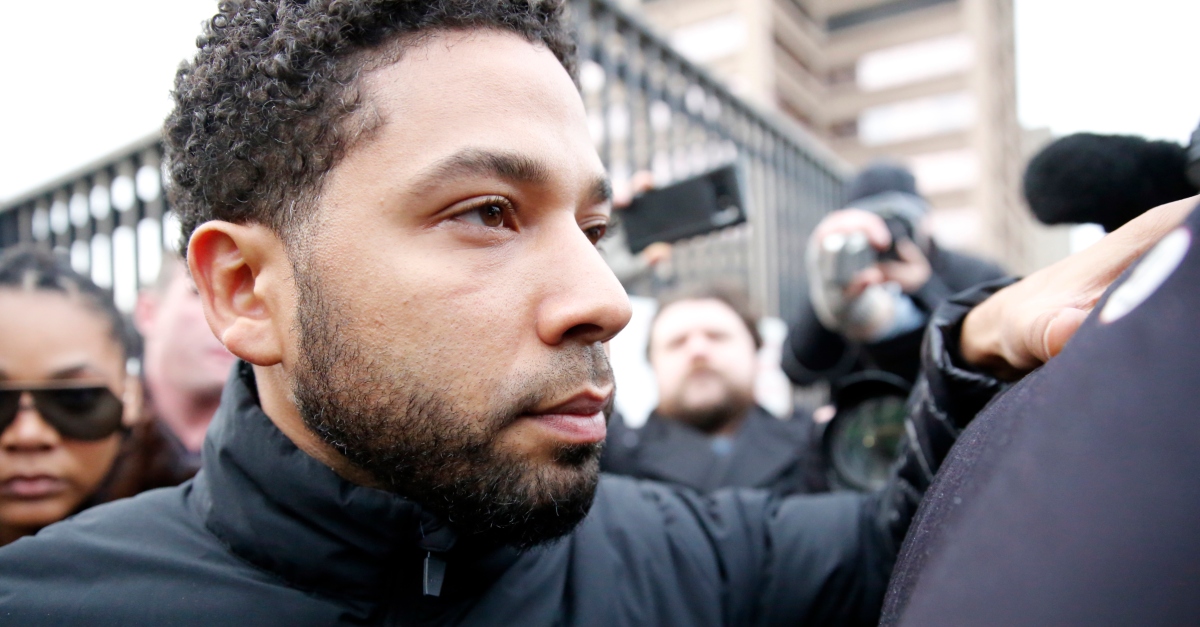
Has Jussie Smollett fatigue settled in yet? The slow drip of information has just begun. Earlier this morning, the official transcript of Smollett’s brief court Tuesday court appearance resulting in dismissal of charges was released. Moments later, Chicago media got hold of a few police reports.
The documents don’t contain any information that’s particularly revelatory about the case and all 13 of them are identified as “supplementary reports” dated March 27, 2019–well after the Chicago Police Department (CPD) had already leaked their concerns that Smollett had staged an alleged hate crime incident perpetrated by MAGA hat-wearing supporters of President Donald Trump.
Law&Crime’s Alberto Luperon took a bird’s eye view look at the reports in a separate article here.
According to the CPD, Abimbola Osundairo and Olabinjo Osundairo were given a $100 bill “which was provided to them to buy the rope, masks and hat for” the allegedly staged attack. The names of the brothers are haphazardly redacted in some places across the reports–while visible in others–so it’s unclear which brother is alleged to have said what and when.
According to the report, one of the brothers “stated he was pretty sure he received the $100 bill from Smollett on January 25,” but wasn’t “sure when and where the bill was used.” There was also no record of the alleged purchases because “he used loose cash to purchase all the items and kept no receipts.”
So, how did police nail down the Osundairo brothers for those purchases–and relate them to the alleged staging of the attack–in the first place? That’s not completely clear, because there are are at least two key pages missing from these sparse reports, but part of the answer comes from a convenience store security camera.
One report, missing an instrumental page, notes that “OSUNDAIRO enter the store and purchase several items, which included gloves, face masks and a red hat.” Subjects now known as [redacted] and [redacted] walk to counter placing several items on counter, including a face mask, knit caps, gloves, a red hat, and sunglasses.” At least two additional cameras in the store capture the same purchase, according to the report, while three cameras apparently weren’t focused on the counter area. A seventh camera is mentioned, but what it captures is unknown because of yet another missing page.
After recovering the video from the store, one of the investigating officers then “purchased one red baseball cap at [the same] location similar to the baseball cap the [officer] observed to be purchased,” the report notes. The hat was then inventoried and the store clerk told police “that he also sold a different red baseball cap and that he was not sure if the hat purchased by the [officer] was identical to the hat observed to be purchased in the video.
The cashier at the store told police “that she remembered selling the ski masks and times” and believed she had sold them “to two or three” African American men. The cashier didn’t believe she would be able to identify the men who purchased the items but did agree to do a “photospread lineup” at her home later on, the report notes. The results of that lineup, however, are not revealed in the report.
Other details in the report are even less earth-shattering: Smollett refused food after he was booked into jail; CPD made several attempts to keep all of the interested parties–Smollett, the Osundairo brothers and their attorneys–away from the media and repeatedly went to restaurants to procure food; and Smollett was apparently never handcuffed during his brief stint in custody.
What the police reports don’t reveal is also sure to be looked upon with interest. Namely, exactly how and when CPD investigators reformulated their hate crime inquiry into a false statement inquiry. There’s a few wayward bits of evidence here and there–but the redacted, summary and partial nature of these reports doesn’t offer a clear timeline–or really much of a timeline at all.
Ultimately, these reports appear to be of a piece with this case’s constant refrain: more questions arise than answers. But maybe that calculus will change, and quick.
On Wednesday afternoon, Cook County State’s Attorney Kim Foxx said the case file will be released–reversing a judge’s decision to have the entire file placed under seal. According to the Illinois Better Government Association, Foxx said the records were being unsealed “probably as we speak.”
Will we learn any more information about former Michelle Obama aide Tina Tchen? Will the case file answer some of the lingering questions about how police and prosecutors handled the Smollett case? We may know soon enough.
[image via Nuccio DiNuzzo-USA TODAY Sports]